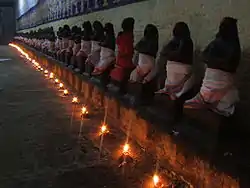Nayanars
The Nayanars (or Nayanmars; Tamil: நாயன்மார், romanized: Nāyaṉmār, lit. 'hounds of Siva', and later 'teachers of Siva')[1] were a group of 63 saints living in Tamil Nadu during the 6th to 8th centuries CE who were devoted to the Hindu god Shiva. Along with the Alwars, their contemporaries who were devoted to Vishnu, they influenced the Bhakti movement in early medieval South India.[2] The names of the Nayanars were first compiled by Sundarar. The list was expanded by Nambiyandar Nambi during his compilation of material by the poets for the Tirumurai collection, and would include Sundarar himself and Sundarar's parents.
| Part of a series on |
| Shaivism |
|---|
 |
History

The list of the Nayanars was initially compiled by Sundarar (Sundararmurthi). In his poem Tiruthonda Thogai he sings, in eleven verses, the names of the Nayanar saints up to Karaikkal Ammaiyar, and refers to himself as "the servant of servants".[2][3][4] The list did not go into the detail of the lives of the saints, which were described in detail in works such as Tevaram.[5]
In the 10th century, king Raja Raja Chola I collected the volumes of Tevaram after hearing excerpts of the hymns in his court.[6]:50 His priest Nambiyandar Nambi began compiling the hymns into a series of volumes called the Tirumurai. He arranged the hymns of three saint poets Sambandar, Appar and Sundarar as the first seven books which he called the Tevaram. He compiled Manikkavasakar's Tirukovayar and Tiruvasakam as the eighth book, the 28 hymns of nine other saints as the ninth book, the Tirumandiram of Tirumular and 40 hymns by 12 other poets as the tenth book. In the eleventh book, he created the Tirutontanar Tiruvanthathi (also known as Tirutoṇṭar Antādi, lit. Necklace of Verses on the Lord's Servants), which consisted of 89 verses, with a verse devoted to each of the saints. With the addition of Sundarar and his parents to the sequence, this became the canonical list of the 63 saints.[5] In the 12th century, Sekkizhar added a twelfth volume to the Tirumurai called Periya Puranam in which he expands further on the stories of each of 63 Nayanars.[1][2][3]
The Nayanars were from various backgrounds, including Channars, Vanniyar, Vellalas, Idayars, Kurumbars, Thevars, oilmongers, Brahmins, Washermen, Harijan, and nobles.[1] Along with the twelve Vaishnava Alwars, they are regarded as the important Hindu saints from South India.
List of Nayanars


Sundarar's original list of Nayanars did not follow any sequence with regards to chronology or importance. However, some groups have since followed an order for arranging their Nayanar temple images according to Sundarar's poem as well as the information from Nambi and Sekkizhar.[3][7]
Other saints
The 9th-century poet Manikkavacakar was not counted as one of the 63 Nayanars but his works were part of the eighth volume of the Tirumurai. Although the traditional count of Nayanars is only 63,[10] the Tamil poet-philosopher Valluvar is often counted as the 64th Nayanar as a sign of honour and is taken in annual procession by various communities, including the Mylapore and the Tiruchuli communities.[11]
See also
References
- Sadasivan, S. N. (2000). A Social History of India. New Delhi: A.P.H. Publishing Corporation. pp. 150–151. ISBN 81-7648-170-X.
- Ramaswamy, Vijaya (2007). Historical Dictionary of the Tamils. Scarecrow Press. p. 167. ISBN 9780810864450.
- Sivananda, Swami. "Sixty-Three Nayanar Saints". The Divine Life Society uttar Pradesh. 19. Tiru Kurippu Thonda Nayanar. Archived from the original on 23 November 2019.
- Mahadevan, T. M. P. (1971). Ten Saints of India (3rd ed.). Bombay: Bharatiya Vidya Bhavan. p. 35. LCCN 70-924698.
- Zvelebil, Kamil (1974). Tamil Literature. A History of Indian Literature. 10. Wiesbaden: Otto Harrasowitz. p. 130. ISBN 3-447-01582-9.
- Cutler, Norman (1987). Songs of Experience: The Poetics of Tamil Devotion. Bloomington: Indiana University Press. ISBN 0-253-35334-3.
- Vanmikanathan, G. "The Sixty-Three Nayanars". Skandagurunatha.org. Archived from the original on 30 September 2019. Retrieved 20 April 2020.
- Das, Sisir Kumar (2005). A History of Indian Literature, 500-1399: From Courtly to the Popular. Chennai: Sahitya Akademi. p. 31. ISBN 81-260-2171-3.
- Narayanan, M. G. S. (1996). Perumals of Kerala: Brahmin Oligarchy and Ritual Monarchy—Political and Social Conditions of Kerala Under the Cera Perumals of Makotai (c. AD 800–AD 1124). Calicut, Kerala: Xavier Press. OCLC 38233093.
- Kāraikkālammai, Peter J. J. de Bruijn (2007). Poems for Śiva, illustrated with masterpieces of Hindu art. Rotterdam: Dhyani Publications. p. 5. ISBN 978-90-811564-2-4.
- Kannan, Kaushik (11 March 2013). "Saint poet's guru pooja at Tiruchuli". The New Indian Express. Tiruchuli: Express Publications. Retrieved 3 September 2020.
Further reading
- Cort, John E. (1998). Open Boundaries: Jain Communities and Culture in Indian History. Albany: State University of New York Press. ISBN 0-7914-3786-8.
External links
- "63 Nayanmarkal". Shaivam.org.
